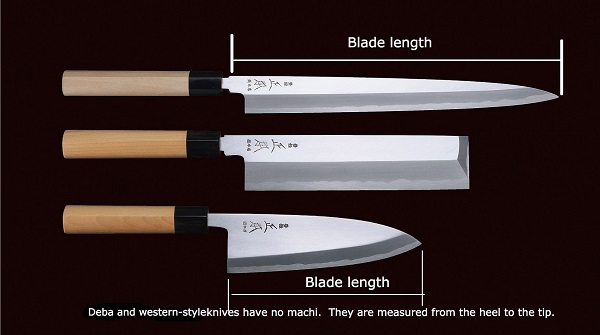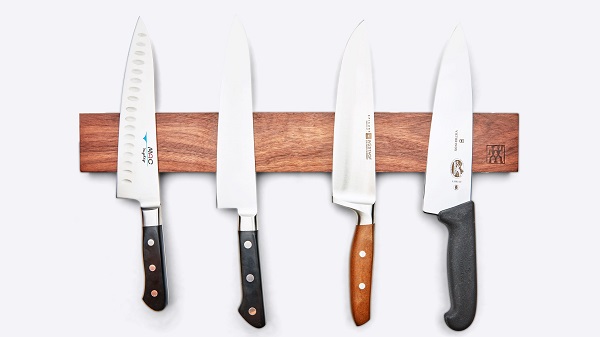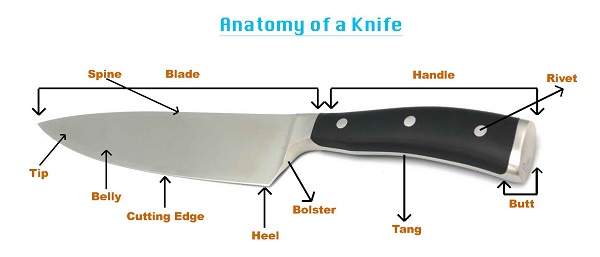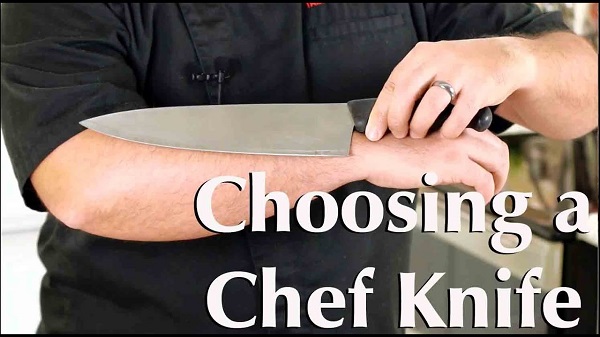It is often said that the knife is the ultimate weapon of any chef. So do you know some tips to measure a knife properly? This is extremely important because it will affect your use in the kitchen later. Battersby wrote this article to help you find the knife that’s right for you!
Contents
How to Measure a Knife Blade Length
When it comes to measuring the length of a knife, it’s specifically blade length. We will measure from the methods of the blade to the bolster. Choose the right length for your knives as you will have to use them often.


The blade length measurement
Knives come in many different shapes and sizes, but the fundamentals of knife parts can be applied to almost any knife. Since chef knives are the most used knives in the kitchen, it is important that you have the correct size.
The length of a knife usually refers to the length of the blade. It will be from the ways of the blade to the bolster.
However, you will see a number of product descriptions measuring the entire knife, from the tip to the hilt. You should tell from the description whether they have done this or not. If the entire knife has been measured, the seller should subdivide the blade length as well as handle length in the description.
If there is only one length stated in the description it should refer only to the length of the blade.
Does Knife Length Include Handle?
Although the length of a knife should describe the length of the blade from tip to pin, many cheaper knives will show a head-to-handle length measurement.
If the length is shown from head to shank, the seller should separate the blade as well as handle length in the description. If only one length is described, it should be the head of the pad.
How Long is a Common Chef’s Knife?
Chef’s knives range in length from 6 to 14 inches, with an average length of 8 inches. The size of your chef’s knife depends on several factors, such as the size of your hand and what you use your chef’s knife for most often.




The knife dimensions
Knives are measured according to the length of the blade, from tip to heel, excluding the length of the handle. So an 8-inch knife will have an 8-inch blade. A 6-inch knife has a 6-inch blade, and so on.
Most knives in your kitchen will be a pretty standard size, it doesn’t matter especially the exact length of your paring or bread knife. But for your master chopping knife or a chef’s knife, size really matters.
A chef’s knife is like an extension of your own arm. You want it to feel comfortable and balanced, if it’s too big for you, it’ll be bulkier and harder to control.
The blade length and popularity:
- Rare: 12 and 14 inches.
- Moderate: 6 and 10 inches.
- Popular: 8 inches.
Anatomy of a Knife




You should always remember important parts of the knives
1. The Blade
The best chef’s knives are made of high carbon stainless steel, which is a very hard metal that stays sharp for a long time and won’t discolor or rust like regular carbon steel.
To be sure, knives created from regular carbon steel are not necessarily inferior. Some cooks love them, because the softer metal makes them easier to sharpen. Of course, they are also easier to dull.
Chef knives are measured in inches. The longer blade allows you to make a longer cut when cutting. The so-called “German” style of chef’s knives tend to have a more curved part at the front of the blade, good for chopping in an up and down “swinging” motion.
The “French” style is straighter and more triangular in shape, which is great for “cutting” movements where the knife is drawn straight towards you.
View more: How to sharpen a serrated knife
2. The Handle
The part of a chef’s knife that you’ll come into most contact with is the handle. So you’ll want to make sure it’s comfortable and fits well in your hand. It won’t feel slippery or make you hold it too hard.
Chef’s knife handles are traditionally made of wood, but wooden handles present certain problems. Because the wood is porous, wooden knife handles can harbor bacteria that cause food-related illnesses.
Plastic or rubber handles rapidly gained popularity because of this. In addition, some handles are made from composite materials including wood that has been treated with plastic resin.
3. The Heel
The heel is the widest part of the knife, located at the back of the blade, where it makes contact with the handle. This blade is used to cut hard items like carrots, nuts or even chicken bones.
Knives with longer blades produce more leverage, thus creating more cutting force at the end of the blade. A heavier knife also increases cutting force, but is also more tiring to use.
4. The Tang
As mentioned earlier, the best knives are forged from a piece of steel that runs along the entire length of the knife. This means the steel extends all the way to the handle. The tang is the steel inside the handle.
5. The Rivets
Rivets are cylindrical studs that are raised to keep the handle firmly attached to the tang of the knife. If there are studs, make sure their tops are smooth. And they don’t protrude from the handle.
6. The Bolster
The support bar is the heavy-duty steel shoulder located at the front of the handle, where it comes into contact with the spine or top (non-cut) edge of the blade. In addition to stabilizing the knife, the pad helps keep your fingers from slipping while you work, thus preventing hand fatigue and blistering.
How to Choose Suitable Blade Length for Your Chef’s Knife




Tip of measurement for the suitable knives
1. Based on Your Height
Since the handle size increases as the chef’s blade size increases, one method to determine the knife size that works best is to use your height as the guide.
Related: How to Remove Rust from Knives
Typically, if you’re under 5 feet 5 inches tall, you’ll be most comfortable with a 6-inch knife. If you’re 5 feet 5 inches to 6 feet tall, you’ll probably want to go with an 8-inch knife.
If you are taller than 6 feet, you will probably work best with a 10-inch knife or maybe even a 12-inch knife if you are taller than 6 feet 3 inches.
2. Based on Your Forearm Length
If you want a slightly more accurate method of determining the size of a chef’s knife that works best for you, try the sizes in the store. Place the tip of the knife on the crook’s elbow and place the blade straight into the forearm.
You want the heel of the blade to reach your wrist. You can also use a ruler and measure the length of your forearm to guide you when buying a chef’s knife.
Conclusion
Through this article, we have learned with you the methods to measure a knife. Plus, you’ve also found a way to choose the knife length that works best for you. Always read the manufacturer’s instructions and description carefully. Always stay sharp!

Fitspresso
Tuesday 5th of March 2024
Hi my family member I want to say that this post is awesome nice written and come with approximately all significant infos I would like to peer extra posts like this
NeuroTest consumer reports
Thursday 29th of February 2024
I was suggested this web site by my cousin Im not sure whether this post is written by him as no one else know such detailed about my trouble You are incredible Thanks
temp email
Monday 12th of February 2024
I do agree with all the ideas you have introduced on your post. They are very convincing and will definitely work. Still, the posts are very short for newbies. May just you please prolong them a little from subsequent time? Thank you for the post.
Gluco Relief
Friday 9th of February 2024
What i do not understood is in truth how you are not actually a lot more smartlyliked than you may be now You are very intelligent You realize therefore significantly in the case of this topic produced me individually imagine it from numerous numerous angles Its like men and women dont seem to be fascinated until it is one thing to do with Woman gaga Your own stuffs nice All the time care for it up
Glucorelief
Friday 9th of February 2024
Thank you I have just been searching for information approximately this topic for a while and yours is the best I have found out so far However what in regards to the bottom line Are you certain concerning the supply